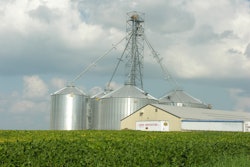They say when trade works, the world wins. In that case, the president’s signing of Free Trade Agreements with Colombia, Panama and South Korea on Oct. 21 was a long-awaited victory for all parties.
Global access is imperative to maintaining a competitive edge, as foreign markets hold the most potential. According to Floyd Gaibler, U.S. Grains Council director of trade policy, the overseas market represents 73% of the world’s purchasing power, 87% of the economic growth and 95% of the world’s customers. The passage of these agreements levels the playing field and gives the United States the same tariff- and duty-free access our competitors have experienced in all three markets.
In total, the United States stands to gain 250,000 jobs and $13 billion in annual exports, making this the largest trade package passed since the North American Free Trade Agreement. Agriculture exports alone could reach more than $2 billion annually, according to the USDA.
Leaders of U.S. grower associations, trade promotion organizations and major agriculture companies sat down withFeed & Grainto explain the unique opportunities and challenges each market represents, and discuss why it’s vital for the United States to aggressively pursue open trade and give our producers the opportunity to compete fairly in the global marketplace.
Colombia: making up lost ground
The most notable objective with respect to the Colombian market is regaining the market share lost from 2007 through 2011 while the agreements sat pending.
Historically, Colombia has been one of the top ten export markets for U.S. corn. During the marketing year of 2007-08 the United States exported 114 million bushels of corn to Colombia, valued at about $627 million, according to Sarah Gallo, National Corn Growers Association director of public policy. By the 2009-10 marketing year, our exports dropped to only 36 million bushels, around $152 million.
“It was an unbelievable decrease in two short years and one of the primary reasons the NCGA was supportive of the Colombia free trade agreement — to get some of that market share back,” says Gallo.
Meanwhile, U.S. wheat had 73% market share in 2008 and plummeted to around 43% by the end of 2010. Gaibler attributed the lost market share to Colombia’s trade agreements with other nations.
“Collectively, the U.S. prior to 2008 had nearly 50% of all of the agriculture imports going into Colombia, valued at that point at more than $2 billion,” said Gaibler. “But we’ve seen this market share decline rapidly to less than 25%. Conversely Argentina’s market to Colombia for total ag imports rose from 8% to 30% over that same time period and Brazil increased from 6% to 9%. That loss of market share can be attributed directly to the fact the U.S. is facing high tariffs, while Brazil and Argentina received duty preference reductions through the MercosurAgreement.”
Colombia’s implementation of new trade agreements extends beyond South America. In August 2011 a trade agreement with Canada went into effect, despite the fact the FTA was signed nearly two years after the U.S./Colombia FTA was signed.
Shannon Schlecht, U.S. Wheat Associates director of policy, explains the negative impact Canada’s expedient signing had on the United States.
“Analysis conducted indicate that U.S. farm gate prices could have been $0.10/bushel higher if the US/Colombia FTA would have been implemented ahead of Canada’s agreement,” Schlecht says. “Canada’s imports have surged since passing their FTA — doubling in the month of August year on year and again more than doubling in September 2011.”
Devry Boughner, director of international business relations for Cargill, one of the largest marketers of food and agricultural products in the United States, says buyers are looking for competitively-priced imports.
“When U.S. export products are priced higher than products from other countries based on trade barriers, U.S. products lose out,” says Boughner.
Despite the fact there’s now more competition in Colombia than ever before, its aggressive pursuit of new trade negotiations means its economy is growing. With the passage of our agreement and the removal of trade barriers, there is significant opportunity for the U.S. to restore its former Colombian market share.
哥伦比亚经济gr预计将超过4%owth annually over the next three years, according to Gaibler. Its percapita income has grown steadily over the past decade and is projected to continue increasing until 2015. As Colombians’ middle class and income continue to grow the consumption of animal proteins will follow.
South Korea: Looking long-term
Unlike Colombia, whose high tariffs caused a sharp decline in U.S. imports, market access to South Korea remained relatively open while the FTA was pending. Corn tariffs, for example, were only at 3% as opposed to Colombia’s 15% tariff on grain.
“Korea is our No. 3 export market, so having the ability to market corn and corn co-products duty free with the implementation of this FTA is a tremendous benefit,” says NCGA’s Gallo.
But the main objective of the South Korean agreement was not swift removal of duties and tariffs. More importantly, the U.S./South Korea agreement facilitates a long-term strategy to build a stronger relationship and a formalized channel through which to negotiate non-tariff trade barriers.
Not all countries quickly accept the innovative agricultural technologies and techniques used in the United States. Regulatory restrictions on pesticide residues, biotechnology and production techniques are all trade-inhibitive to U.S. ag products.
So before implementation of any Free Trade Agreement, the two governments must determine if there are regulatory barriers to resolve.
Korea has historically been proactive in adopting events as they’re approved in the United States, and according to USGC’s Gaibler, there are currently no significant barriers to address. But in the absence of an FTA, Korea would have been able to implement trade-restricting regulations without any obligation to the United States to work on a resolution. The United States’ Free Trade Agreement with South Korea will prevent any unforeseen non-tariff barriers in the future.
Gary C. Martin, president & CEO of the North American Export Grain Association, says without a commitment to open markets, there is a risk of shocking the marketplace when a new technology or production technique is implemented in the United States.
“[The FTA] allows us to deal with some of our concerns on a formalized and established basis,” says Martin. “It provides for increased predictability and transparency so more people can participate, efficiencies can be brought into the marketplace and we can have confidence that our product is going to be accepted once it’s shipped,”
The agreement with Korea also represents an in-road to the Asian market as a whole. The growth in Asia — led by China — that is anticipated in the coming decade, makes the Asian market especially attractive, says NAEGA’s Martin.
The U.S. government is currently engaged in talks to form the Trans-Pacific Partnership with several nations, including Malaysia, Singapore and Vietnam. Martin says the South Korean FTA is a stepping stone in the right direction toward U.S. trade relations with other Asian nations.
“美国/韩国的实现自由Trade Agreement establishes the fact that we can negotiate and conclude an agreement with a country with an economy as significant as Korea’s,” says Martin. “The Trans-Pacific partnership in many ways builds on existing sets of bi-lateral agreements that facilitate trade in more ways than just reducing tariffs.”
Panama: Logistical key
Panama is smallest market of the three FTAs signed in October, but its central role in global trade from a logistical standpoint makes it as vital to the United States as the rest. Serving as the gateway from the Atlantic Ocean to the Pacific Ocean, more than one million vessels have passed through the waterway since its opening in 1914, according to 2010 data from the Panama Canal Authority.
A canal expansion project scheduled to complete in 2014 means volume moving through the Panama Canal will continue to increase. The program construction includes two new sets of locks – one on the Pacific and one on the Atlantic side of the Canal — as well as the widening and deepening of existing navigational channels in Gatun Lake and the deepening of Culebra Cut.
But Panama is more than a mere passageway, and could represent an untapped market for high-value finished products. If incomes continue to raise for the general population, high value agriculture goods — food products — will move into the market.
“Panama already had access while the FTAs were pending, but it’s still an advantageous agreement from the perspective that we can sell our premium products to a growing premium products market,” says Martin. “I don’t expect Panama to feed more livestock or for U.S. corn to have more access to livestock feed in Panama like I do in Colombia, but I do expect the high value foods to move into Panama and we will support their economic growth.”





















